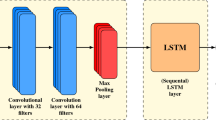Abstract
Neuro-fuzzy system is now one of the most widely used tools in the field of artificial intelligence systems. This study proposes a novel approach for time series stock market price prediction using a recurrent error-based neuro-fuzzy system with momentum (RENFSM). The basic idea of this approach is to use time series price momentum and time series prediction error adjusted to the well-known adaptive neuro-fuzzy inference system, ANFIS. Extended from ANFIS, the aim of this study is to propose a reliable prediction system with minimal error. Moreover, to evaluate the proposed model strength, four top-listed stocks from Dhaka stock exchange were applied. In the experiments, several choices of momentum from 3 to 20 days are selected for data preprocessing. It was found that the proposed RENFSM performed superiorly and was more reliable compared to the existing methods such as ANFIS and neural networks.





















Similar content being viewed by others
References
Abbasi E, Abouec A (2008) Stock price forecast by using neuro-fuzzy inference system. World Acad Sci Eng Technol 2(10):270–273
Boyacioglu MA, Avci D (2010) An Adaptive Network-Based Fuzzy Inference System (ANFIS) for the prediction of stock market return: The case of the Istanbul Stock Exchange. Exp Syst Appl 37:7908–7912
Chang PC, Liu CH (2008) A TSK type fuzzy rule based system for stock price prediction. Exp Syst Appl 34:135–144
Diebold FX (2012) Comparing predictive accuracy, twenty years later: a personal perspective on the use and abuse of Diebold–Mariano tests. No. 18391. National Bureau of Economic Research Inc
Diebold FX, Mariano RS (1995) Comparing predictive accuracy. J Bus Econ Stat 13:253–263
Esfahanipour A, Aghamiri W (2010) Adapted Neuro-Fuzzy Inference System on indirect approach TSK fuzzy rule base for stock market analysis. Exp Syst Appl 37:4742–4748
Fung GPC, Yu JX, Lam W (2002) News sensitive stock trend prediction. Advances in knowledge discovery and data mining (PAKDD 2002). LNAI 2336:481–493
Guldal V, Tongal H (2010) Comparison of recurrent neural network, adaptive neuro-fuzzy inference system and stochastic models in Egirdir lake level forecasting. Water Resour Manag-Springer 24(1):105–128
Han M, Xi J, Xu S, Yin FL (2004) Prediction of chaotic time series based on the recurrent predictor neural network. IEEE Trans Signal Process 52:3409–3416
Ho SL, Xie M, Goh TN (2002) A comparative study of neural network and Box-Jenkins ARIMA modeling in time series prediction. Comput Ind Eng 42:371–375
Hou L, Zong G, Wu Y (2011) Robust exponential stability analysis of discrete-time switched Hopfield neural networks with time delay. Nonlinear Anal: Hybrid Syst 5(3):525–534
Huang YR, Kang Y, Chu MH, Chien SY, Chang TP (2009) Modified recurrent neuro-fuzzy network for modeling ball-screw servomechanism by using Chebyshev polynomial. Exp Syst Appl 36:5317–5326
Hyndman RJ, Koehle AB (2006) Another look at measures of forecast accuracy. Int J Forecast 22:679–688
Jang JSR (1993) ANFIS: adaptive-network-based fuzzy inference system. IEEE Trans Syst Man Cybern 23(3):665–685
Jerome T, Connor R, Martin D (1994) Recurrent neural networks and robust time series prediction. IEEE Trans Neural Netw 5(2):240–254
Jiao T, Zong G, Zheng W (2013) New stability conditions for GRNs with neutral delay. Soft Comput 17(4):703–712
Kumar DN, Raju KS, Sathish T (2004) River flow forecasting using recurrent neural networks. Water Resour Manag 18:143–161
Lin ZC, Liu CY (2001) Application of an adaptive neuro-fuzzy inference system for the optimal analysis of chemical-mechanical polishing process parameters. Int J Adv Manuf Technol 18(1):20–28
Liu F, Du P, Weng F, Qu J (2007) Use clustering to improve neural network in financial time series prediction. Third Int Conf Nat Comput 2:89–93
Mastorocostas PA, Theocharis JB (2002) A recurrent fuzzy-neural model for dynamic system identification. IEEE Trans Syst Man Cybern 32:176–190
Michie D, Spiegelhalter DJ, Taylor CC (1994) Machine learning, neural and statistical classification. Ellis Horwood
Neto MCA, Tavares G, Alves VMO, Cavalcanti GDC, Ren TI (2010) Improving financial time series prediction using exogenous series and neural networks committees. International Joint Conference on Neural Networks, pp 1–8
Olaniyi SAS, Adewole KS, Jimoh RG (2011) Stock trend prediction using regression analysis—a data mining approach. ARPN J Syst Softw 1(4):154–157
Qian B, Rasheed K (2007) Stock market prediction with multiple classifiers. Appl Intell 26:25–33
QianYu L, ShaoRong F (2010) Stock market forecasting research based on Neural Network and Pattern Matching. International conference on E-Business and E-Government (ICEE), pp 1940–1943
Sun B, Li TK (2010) Forecasting and identification of stock market based on modified RBF neural network. In: IEEE 17th International Conference Industrial Engineering and Engineering Management (IE&EM), pp 424–427
Trinkle BS (2005) Forecasting annual excess stock returns via an adaptive network-based fuzzy inference system. Intell Syst Account Finance Manag 13(3):165–177
Zhang J, Morris AJ (1999) Recurrent neuro-fuzzy networks for nonlinear process modeling. IEEE Trans Neural Netw 10:313–326
Zong G, Liu J, Zhang Y, Hou L (2010) Delay-range-dependent exponential stability criteria and decay estimation for switched Hopfield neural networks of neutral type. Nonlinear Anal: Hybrid Syst 4(3):583–592
Author information
Authors and Affiliations
Corresponding author
Additional information
Communicated by V. Loia.
Rights and permissions
About this article
Cite this article
Mahmud, M.S., Meesad, P. An innovative recurrent error-based neuro-fuzzy system with momentum for stock price prediction. Soft Comput 20, 4173–4191 (2016). https://doi.org/10.1007/s00500-015-1752-z
Published:
Issue Date:
DOI: https://doi.org/10.1007/s00500-015-1752-z




